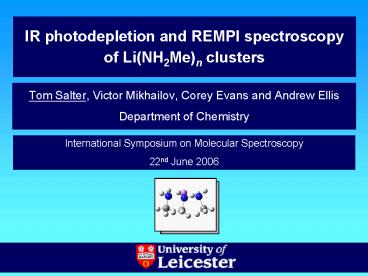IR photodepletion and REMPI spectroscopy of LiNH2Men clusters - PowerPoint PPT Presentation
1 / 14
Title:
IR photodepletion and REMPI spectroscopy of LiNH2Men clusters
Description:
Increased steric bulk may affect onset of the closure of the first solvation shell ... Due to increased steric bulk from methyl group ... – PowerPoint PPT presentation
Number of Views:61
Avg rating:3.0/5.0
Title: IR photodepletion and REMPI spectroscopy of LiNH2Men clusters
1
IR photodepletion and REMPI spectroscopy of
Li(NH2Me)n clusters
- Tom Salter, Victor Mikhailov, Corey Evans and
Andrew Ellis - Department of Chemistry
International Symposium on Molecular Spectroscopy
22nd June 2006
2
Content
- Background
- Experimental
- Results
- Li(MeNH2)n Experimental and theoretical
- Conclusions
- Future work
3
Background
- Very little experimental or theoretical work
undertaken on metal-methylamine clusters - All solution phase ESR and neutron diffraction
- Will provide more information on the nature of
the solvated electron - Extrapolation back to bulk solution
- May expect to see stretches in C-H region along
with N-H - Increased steric bulk may affect onset of the
closure of the first solvation shell - Current results are only preliminary
4
Spectroscopic mechanism
- Excitation of N-H stretching region with tuneable
IR radiation - Fixed wavelength UV laser, set just above IP,
used to ionise clusters - Resonance results in the loss of a solvent
molecule leading to ion depletion - Requires the solvent binding energy to be less
than that of the IR photon and for
predissociation to be fast enough (ns or less)
5
Experimental
6
Li(MeNH2)n
- Mass spectrum
- Up to 15-fold increase in ion production observed
for n 1, 2 and 3 - Depletion seen for larger clusters
(a)
- (a) IR OFF
- (b) IR ON
(b)
7
Li(MeNH2)n
- IR depletion spectra for n 4 and 5
n 2
- Only recorded so far using a fixed and short UV
wavelength, 248 nm - See depletion of large clusters and corresponding
production of small clusters - Under tighter IR focal conditions, production
also seen in n 1 channel - Possibility of fragmentation
n 3
n 4
n 5
8
Calculations
- Calculations still underway
- B3LYP/
- 6-311G(d,p)
- More conformational isomers possible so
systematic searching is more involved - Lowest energy predicted spectra for n 1-4 show
very similar trends making assignment problematic - Difficult to be sure where ion production for
small clusters is originating from
n 4 Experimental
n 1
n 2
n 3
n 4
9
Calculations
- Possible that several low energy isomers are
adopted resulting in spectral broadening - 3 isomers predicted for n 2
- 12 isomers predicted for n 3
- gt20 isomer predicted for n 4
- Due to increased steric bulk from methyl group
- Calculations indicate closure of the first
solvation shell with 3 methylamine molecules - In contradiction to neutron diffraction data,
which predicts closure of the first solvation
shell with 4 molecules
- Dissociation energies
- n a) DFT
- 1 4596
- 2 4019
- 3 4160
- 4 1370
- Thus IR absorption for n ? 4 could induce loss of
an ammonia molecule - a) Lowest energy conformer in each case
10
Improvements
- Contributions from larger clusters may present a
serious problem for identification - Possible solution would be excitation downstream
from ionisation - Small clusters will miss MCP
- Record spectra at wavelengths just above a
cluster IP - Aim to minimise fragmentation
Time-of-Flight extraction region
Excitation and ionisation in the same region.
Fragments detected
Excitation spatially separated from ionisation.
Fragments not detected
11
Conclusions
- Preliminary spectroscopic data obtained
- Li(MeNH2)n clusters for n 4 and 5 show IR
photodepletion spectra - This depletion is mirrored by ion production for
n 1, 2 and 3 - Calculations provide the first indication that
the first solvation shell is closed with 3
solvent molecules - Plausible due to increased steric hindrance from
methyl group - Assignment problematic as spectra for n 1-4 are
very similar - Dissociation energies consistent with depletion
from n 4 - Further work is required on these clusters, such
as experimental determination of IP - Confirm extrapolation to the bulk phase
- Identify trends confirming closure of the first
solvation sphere
12
Future Work
- Have a general methodology for recording
mass-selected IR spectra of solute-solvent
clusters - Can explore other metal solutes, e.g.
- Other alkali metals
- Alkali metal clusters, e.g. Li2, Li3
- Alkaline earth and transition metals such as Cu
- Molecular solutes
- e.g. acids such as HCl or HNO3, salts, etc.
- Different solvents
- e.g. water, alcohols, methanol, acetonitrile, etc.
13
Acknowledgements
- Funding principally EPSRC
- University of Leicester Centre for Mathematical
Modelling - Mechanical and electronic workshops
14
Additional
- IR production spectrum for Li(NH3)1
- Peaks in C-H stretching region visible































